Posted: September 19th, 2015 | No Comments »
Plenty has been written on the popularity of Jazz in interwar Shanghai and the large number (comparatively) of African-American jazz musicians, singers and bands that passed through the city. I won’t rehash everything here – black musicians had been appearing in Shanghai since the early part of the twentieth century (as chronicled in a number of books including Andrew Field Shanghai’s Dancing World) and this process accelerated as Shanghai, both Chinese and Shanghailander, came to appreciate and want more jazz. The factors attracting African-American musicians and entertainers were multiple of course:
- Social – Shanghai was generally perceived as being somewhere with distinctly less prejudice, racism and exclusionary practices than America (mostly true, though racism both formal and informal did exist and was experienced – plenty of Shanghailanders were racist, some clubs and dancehalls operated informal colour bars while some places, like the American Club, operated formal bars; the 4th Marines stationed in the city were a fairly aggressive bunch too);
- Market – the growing demand for jazz in the city, the proliferation of venues and the perceived authenticity of black musicians (though obviously there was also a demand for white bands, either American, European or made up of Russians, Italians, Filipinos etc in Shanghai);
- Economic – for most of the period wages were pretty good, taxes low to non-existent and the exchange rate in America’s favour (though how you were paid, in what currency, whether you got cheated etc depended on the generosity or otherwise as well as the honesty of the employer).
Reading William A Shack”s Harlem in Montmartre, about the Paris jazz scene and specifically the crucial role of African-American musicians between the wars we can add another “push” factor that encouraged African-American entertainers to travel to Shanghai – the French 10% law…
Paris had of course been a Mecca to black American jazz musicians after World War One – black servicemen that stayed on after the Great War in the more liberal environment of Paris, more that came once word got out, others booked for European tours who found Paris congenial. However, in June 1933 France enacted the so-called 10% law. Enacted in the wake of the onset of the Great Depression in Europe the law restricted the number of foreign musicians employed by an establishment to 10%. This naturally caused a lot of unemployment and, while many stars and band leaders remained in work, many ordinary musicians found themselves unemployed.
Among those who found themselves struggling to make a living in Paris and lit out for Shanghai were:
- Bob and Teddy Drinkard – who took their floor show to the Canidrome Ballroom in Frenchtown
- Nora Holt Ray – a singer who worked in various Shanghai nightclubs


- Al Baldwin – who worked in Shanghai floor shows for six years
- Ulysses S (“Slow Kid”) Thompson – the husband of the (recently deceased) Florence Mills who got a gig at Shanghai’s Little Club
 Thompson with Florence Mills
Thompson with Florence Mills
Of course after 1933, and things got tougher in Paris, American bands circumvented Europe and went straight to Shanghai with greater regularity. But it seems France’s decision to enact the 10% law saw a lot head straight to Marseilles and jump the Messagerie Maritime boat to Shanghai.
Posted: September 18th, 2015 | No Comments »
An interesting book on one of South East Asia’s most influential architects of the early twentieth century….
(and an upcoming event on Iversen at Asia House in London on November 25th)
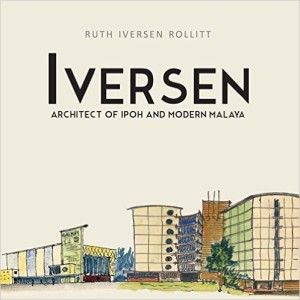
Perhaps more than any other architect of his generation, B.M. Iversen (1906 1976) introduced modern architecture to Malaya. From his award-winning Federal House and the landmark Loke Yew Building in Kuala Lumpur, to the 38 cinemas he designed for the Shaw Brothers and the Cathay Organisation, Iversen s buildings remain icons of Malaysian Art Deco and Modernist architecture. Arriving in Malaya in 1928, the young Danish architect worked for Booty & Edwards and then Keys & Dowdeswell before moving to Ipoh. There, he settled down, founded his own practice and began to experiment with variants of tropical architecture. He was joined by his Dutch friend Henk van Sitteren after the war. By the time Iversen retired in 1966, the partnership of Iversen & van Sitteren had grown into a large firm with 14 architects of Danish, Dutch, British, and Malayan nationalities. The firm was responsible for the design of thousands of buildings in Penang, Perak, Cameron Highlands, Kuala Lumpur and Singapore. Written by the architect s daughter, Ruth Iversen Rollitt, this warm, richly illustrated biography sheds new light on the life and work of Iversen, whose career spanned almost four decades in Malaya.
Posted: September 18th, 2015 | No Comments »
If tyou need a reason to visit Paris (and you shouldn’t really) here’s a couple. Not one, but two, exhibitions featuring the work of the early photographer in China and Taiwan John Thomson are taking place in Paris this autumn. One exhibit, of Thomson’s Taiwan photographs, will be held at the Maison de la China and opens in late September. The other, of Thomson’s China photographs, will be held at the Fondation Taylor beginning at the end of October. More information on both exhibitions here. For anyone interested there’s also a 15-page press kit here.

Posted: September 17th, 2015 | No Comments »
I’ve blogged before about the various tactics the Nazi authorities resident in Shanghai in the 1930s used against the Jewish population of the International Settlement (here, threatening retribution against their relatives back in Europe if they staged an anti-Nazi play in Hongkew). Here though is another tactic the Nazis used in Shanghai – dredging up the old ‘Jewish blood rituals’ nonsense.
It’s a long standing bit of rubbish used by Nazis in Europe and anti-Semites for ages….here given a Shanghai twist. The gist is that Jews had an ‘operating table’ in the Jewish cemetery in the old Eastern District (Yangpu nowadays) where they ritualistically murdered non-Jews. The Nazi slanders intimated that such ritualistic killings by Jews of non-Jews had gone on during the First World War. This was, of course, and as the Shanghai Municipal Council and the newspapers including the North-China Daily News reported, nonsense – not least because the Jewish cemetery (at 727 Baikal Road in Yangtszepoo District – now Huimi Road/Weiming Road in Yangpu) was only founded in 1917 and didn’t really come into use until 1919. However, it does show how active the Nazi propaganda machine was in spreading anti-Semitic ideas in Shanghai in the late 1930s and 1940s.
What is not totally clear is who exactly the Nazi agents were directing their propaganda at? Shanghailanders or Chinese in Shanghai.
BTW: Baikal Road was the biggest Jewish cemetery in Shanghai, consisting of 1,692 graves. The dismantling of monuments and exhumation of remains started September 1958 and was completed November 1958. Re-interment was reportedly completed on December 1958.
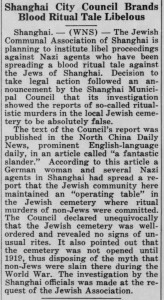
Posted: September 16th, 2015 | No Comments »
I do know Dave Schooler was a Jewish bandmaster who had a long career and carried on through World War Two – as to what his show “Shanghai” was all about…I have no idea….
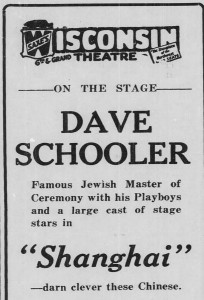
Posted: September 15th, 2015 | No Comments »
There aren’t many novels that deal with the fall out from the end of the Dutch East Indies, the collapse of Holland’s empire in the Far East and the creation of Indonesia. However, Janwillem van de Wetering’s Outsider in Amsterdam does, to an extent. A central figure in the novel, set in Amsterdam, is a former Papuan fighter living in Amsterdam. Van de Wetering was Dutch, but lived for a time in Japan and was a student of Zen Buddhism. Published in 1975 it was the first in Van de Wetering’s Grijpstra and de Gier detective series.
On a quiet street in downtown Amsterdam, the founder of a new religious society/commune-a group that calls itself ‘Hindist’ and mixes elements of various ‘Eastern’ traditions-is found hanging from a ceiling beam. Detective-Adjutant Grijpstra and Sergeant de Gier of the Amsterdam police are sent to investigate what looks like a simple suicide, but they are immediately suspicious of the circumstances.
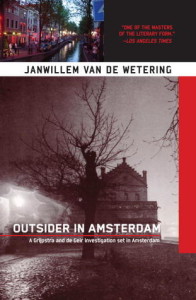
Earlier covers highlighted the East Indies theme a bit more in various ways (not always strictly accurately)….
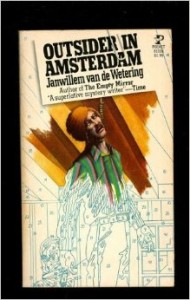

Posted: September 15th, 2015 | 1 Comment »
There’s now a Japanese translation of Midnight in Peking out there…..

Posted: September 15th, 2015 | No Comments »
American newspapers gossip about Chiang Kai-shek and whether or not he’s up to the job in 1944….












